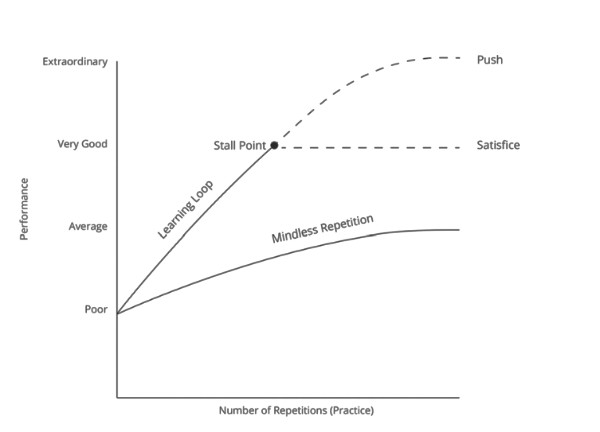
Since I saw this diagram in Mansen’s Great at Work, it’s haunted me.
How often am I tempted to satisfice, when it comes to learning something? (Satisficing is a play on words that combined “satisfying” and “sufficing”.)
Stanford Professor Carol Dweck argues that leaders need a growth mindset, to push beyond the stall. In Dweck’s theory, those who believe that you either have talent or not (a fixed mindset) don’t bother to improve much, while those who believe talent is malleable (a growth mindset) put in extra effort, even when they excel at something.
Pushing and improving regardless of our past achievements prevents us from falling into a common trap: the stall point. As we develop expertise and skill in an activity, we can become very good, maybe even excellent. But then something happens, we plateau.
We stop. We judge ourselves “good enough.” We satisfice.
After 20 years of doing the “If Properly Led” conference, I’m tempted to say “it’s good enough.” I’m hoping you’ll speak into that if you ever see that happening. Laurie and I are constantly trying to keep learning. To not rest, to push beyond the stall.
Let’s work to never satisfice when it comes to our learning, our leadership, our life.
____________________

Let me give you a book suggestion: I’ve been reading A Mind For Numbers: How to Excel at Math and Science (Even If You Flunked Algebra) by Barbara Oakley. It’s a manual on learning. And it is excellent–even for a historian. I will no doubt review portions in this newsletter in the future.
Here’s a good video book summary:
https://www.youtube.com/watch?v=o0ch9l6GcD0
Related Thoughts:
Mansen’s Great at Work also suggests the constant use of the learning loop.
Let’s not just learn, let’s loop. Leaders and learners with a growth mindset don’t just practice practice practice to become better, they work smarter by “learning as they work.”

In The Culture Code (reviewed below), the author shares one of the secrets of the Navy SEALS, related to this posture of learning as they work. I referenced it in my last letter—this Practice of After Action Reviews.
Central to the SEALS’s effectiveness is a probing**After Action Review,**a truth-telling session led not by commanders but by enlisted men.
These reviews are structured around five core questions:
1 “What were our intended results?*
2 “What were our actual results?*
3 “What caused our results?*
4 “What would we do the same next time?*
5 “What will we do differently?”*